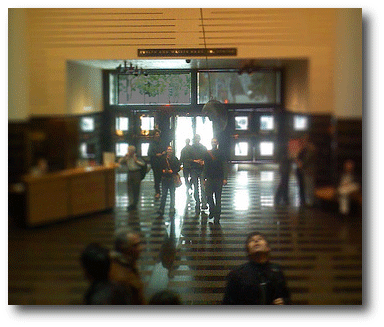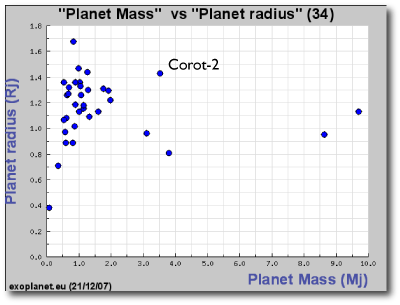
Image Source.
The CoRoT mission announced their second transiting planet today, and it’s a weird one. The new planet has a mass of 3.53 Jupiter masses, a fleeting 1.7429964 day orbit, and a colossal radius. It’s fully 1.43 times larger than Jupiter.

The surface temperature on this planet is likely well above 1500K. Our baseline theoretical models predict that the radius of the planet should be ~1.13 Jupiter radii, which is much smaller than observed. Interestingly, however, if one assumes that a bit more than 1% of the stellar flux is deposited deep in the atmosphere, then the models suggest that the planet could easily be swollen to its observed size.
The surest way to heat up a planet is via forcing from tidal interactions with other, as-yet unknown planets in the system. If that’s what’s going on with CoRoT-exo-2 b, then it’s possible that the perturber can be detected via transit timing. The downloadable systemic console is capable of fitting to transit timing variations in conjunction with the radial velocity data. All that’s needed is a long string of accurate central transit times.
The parent star for CoRoT-exo-2-b is relatively small (0.94 solar radii) which means that the transit is very deep, of order 2.3%. That means good signal to noise. At V=12.6, the star should be optimally suited for differential photometry by observers with small telescopes. With a fresh transit occurring every 41 and a half hours, data will build up quickly. As soon as the coordinates are announced, observers should start bagging transits of this star and submitting their results to Bruce Gary’s Amateur Exoplanet Archive. (See here for a tutorial on using the console to do transit timing analyses.)

Just added to Wikipedia. Would you mind check the entry is correct?
http://en.wikipedia.org/wiki/COROT-Exo-2b
Thanks!
The COROT team must have nearly 150/1.75 transits for this planet, so perhaps they have already detected transit timing variations. It will be interesting to see.
Pingback: Free Encyclopedia » Blog Archive » COROT-Exo-2b
exo-1b:
transit depth= ~1.9 %,
period = 1.509 d,
V=13.6
exo-2b:
transit depth= ~2.4,
period = 1.749 d,
V=12.7
they look sort of like the types of planets found by ground-based transit surveys– absolutely whopping transit depths and periods near small integer ratios of days.
which is interesting given they have photometric precision of like 10^-5, and they are not subject to the observational window issues that bias ground-based transit discoveries towards planets with periods at integer ratios of days. why did they put it in space? just kidding :)
The light curve for exo-2b looks really cool- like a waveform of two out-of-tune flutes.
pnutzman, I guess the fact the planets detected by COROT have to be officially confirmed on the ground lets the easier to confirm come first…
After that much hype, this is dissapointing that CoRoT announces only that (with a lot of self-praising). Very disappointing.
Hi,
it looks as if one of the next Corot planets to be published is really unusual, with the size of Jupiter and half the density of Saturn…
See the text below from the blog http://spaceurope.blogspot.com/.
“Malcolm Fridlund just indicated spacEurope something that, for me, is of extreme importance in the near future…Even if the majority of this light curves reveal to be derived from stellar the ones that aren’t are like precious gems…why? Because all of the 40 light curves are from sun-like stars, so…any exoplanet found under this circumstances might be of a well known nature.
Another point from my latest post had to do with two particular candidates, being one of them presented almost as a teaser…Fridlund revealed to spacEurope what’s the secret…
The exoplanet candidate in question was presented as a jovian sized planet with an unusual density…According to the scientist it is indeed “very unusual”…
If Saturn as a density of 0,7 g/cc this baby has 0,35 g/cc, yes…half of it…
Where does this takes us? As Fridlund tells us, there can’t be any metals in that planet.”
Merry Christmas !
Luis
spaceurope? This blog nauseatingly worships CoRoT, blind to any shortcoming and faults, as any group of believers. They will never ask inconvienent questions to CoRoT team (with god-like Fridlund as leader), such as why after that much hype, teasers and supposedly wonderous preformance…
is only one result, and in addition completely NOT surprising (hot Jupiter? as NEWS? hello… this is 2007, not 1997!).
“They will never ask inconvienent questions to CoRoT team” I guess now you can ask yourself your own incovenient questions to COROT team go ask yourself at http://spaceurope.blogspot.com/
“I thought on proposing something to Dr. Malcolm Fridlund, the project scientist for the COROT mission, which he accepted by being, like an exoplanetary Santa Claus, to answer the questions of this blog’s readers.”
MaDeR, I don’t think the blogging about CoRoT qualifies as worship. All the hype, as far as I can tell, is the fault of those who expected so much of CoRoT. Honestly, I was expecting 50 or so planets. This was an uninformed guess, so I am not horrifically bothered by the reporting of merely one planet. However, yes, they did blow it out of proportion. Hot Jupiters don’t really deserve that much attention.
“I guess now you can ask yourself your own incovenient questions to COROT teamâ€
Yes, but guess who selects questions? This is through spaceurope@gmail.com…
“I don’t think the blogging about CoRoT qualifies as worship.”
Blogging in itself – no. But there are different ways to write about something. In my opinion, tone of recent posts on this blog brushes on worshipping and looks like they write this while kneeling.
“All the hype, as far as I can tell, is the fault of those who expected so much of CoRoT.”
I am afraid that some official statements and relases from CoRoT and ESA ignited this hype and misled many people (me included), so this is their fault. Especially hilarious is this ESA statement: http://www.esa.int/SPECIALS/COROT/SEMF0C2MDAF_0.html
Surpirses? What suprises? Yet another hot jupiter is that “surprise”? Blowed out of proportions indeed.
Sounds like Kepler will be needed after all. With 230,000 stares, progressively reduced to a 100,000 and with a ‘stare’ of 3.5 years, oh my!
If the chances of detecting Earth is ~0.5%, Corot’s 150 day stare quickly whittles down the chance of a transit detection to ~.1% or less. So from a random sample of 10,000 stars, assuming that only 1/3 of the stars are usable less than 3 rocky planets can be expected per ‘stare’.
Due to the ingress depth these can not be followed up except by other space telescopes. So how do they plan to follow up any rocky planets, I wonder?
I’m with MaDeR on this one, maybe not so profanely,:-> but, yes, what was all the hype on this mission. It is almost clear that they will break little new ground.
This could still change, but am not holding my breath.
As for that COROT planet with an unusually low density, why wait, why fuss? We already have TRES-4, which has an even lower density.
Besides the worshipping and kneeling factors are you now suggesting that I will censor inconvinient questions?
You are wrong…
All of them will be adressed to Dr. Fridlund who, as few, made himself available to clear the general public doubts, I believe that this is really valuable in spite of the opinion you might have about my approach to the theme.
spacEurope is a place open to receive your critics and ideas, I make that clear in several posts. The blog is now making a year and I have always, during this time, insisted for its readers to express their opinions and leave their suggestions. The idea is to improve.
In the meanwhile, sorry for not pleasing all.